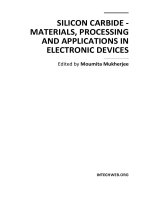supercapacitors materials, systems, and applications (2013, wiley VCH verlag gmbh co KGaA)
Bạn đang xem bản rút gọn của tài liệu. Xem và tải ngay bản đầy đủ của tài liệu tại đây (6.59 MB, 560 trang )
Edited by
¸
Franc¸ois B´eguin and El˙zbieta Frackowiak
Supercapacitors
Related Titles
Stolten, D., Emonts, B. (eds.)
Fuel Cell Science and
Engineering
Materials, Processes, Systems and
Technology
Aifantis, K. E., Hackney, S. A., Kumar, R. V.
(eds.)
High Energy Density Lithium
Batteries
Materials, Engineering, Applications
2012
2010
ISBN: 978-3-527-33012-6
ISBN: 978-3-527-32407-1
Park, J.-K.
Ozawa, K. (ed.)
Principles and Applications of
Lithium Secondary Batteries
Lithium Ion Rechargeable
Batteries
2012
Materials, Technology, and New
Applications
ISBN: 978-3-527-33151-2
2009
Daniel, C., Besenhard, J. O. (eds.)
Handbook of Battery Materials
2nd completely revised and enlarged
edition
2011
ISBN: 978-3-527-31983-1
O’Hayre, R., Colella, W., Cha, S.-W.,
Prinz, F. B.
Fuel Cell Fundamentals
ISBN: 978-3-527-32695-2
ISBN: 978-0-470-25843-9
Zhang, J., Zhang, L., Liu, H., Sun, A.,
Liu, R-S. (eds.)
Electrochemical Technologies
for Energy Storage and
Conversion
2011
ISBN: 978-3-527-32869-7
¸
Edited by Franc¸ois B´eguin and El˙zbieta Frackowiak
Supercapacitors
Materials, Systems, and Applications
The Editors
Prof. Franc¸ois B´eguin
Poznan University of Technology
Faculty of Chemical Technology
u1. Piotrowo 3
Poznan, 60-965
Poland
¸
Prof. Elz˙ bieta Frackowiak
Poznan University of Technology
Institute of Chemistry and Technical Electrochemistry
u1. Piotrowo 3
Poznan, 60-965
Poland
All books published by Wiley-VCH are
carefully produced. Nevertheless, authors,
editors, and publisher do not warrant the
information contained in these books,
including this book, to be free of errors.
Readers are advised to keep in mind that
statements, data, illustrations, procedural
details or other items may inadvertently be
inaccurate.
Library of Congress Card No.: applied for
British Library Cataloguing-in-Publication
Data
A catalogue record for this book is available
from the British Library.
Bibliographic information published by the
Deutsche Nationalbibliothek
The Deutsche Nationalbibliothek
lists this publication in the Deutsche
Nationalbibliografie; detailed bibliographic
data are available on the Internet at
<>.
2013 Wiley-VCH Verlag GmbH & Co.
KGaA, Boschstr. 12, 69469 Weinheim, Germany
All rights reserved (including those of
translation into other languages). No part
of this book may be reproduced in any
form – by photoprinting, microfilm, or any
other means – nor transmitted or translated
into a machine language without written
permission from the publishers. Registered
names, trademarks, etc. used in this book,
even when not specifically marked as such,
are not to be considered unprotected by law.
Print ISBN: 978-3-527-32883-3
ePDF ISBN: 978-3-527-64669-2
ePub ISBN: 978-3-527-64668-5
mobi ISBN: 978-3-527-64667-8
oBook ISBN: 978-3-527-64666-1
Materials for sustainable energy and
development (Print) ISSN: 2194-7813
Materials for sustainable energy and
development (Internet) ISSN: 2194-7821
Typesetting Laserwords Private Limited,
Chennai, India
Printing and Binding Markono Print Media
Pte Ltd, Singapore
Cover Design Simone Benjamin, McLeese
Lake, Canada
Printed in Singapore
Printed on acid-free paper
V
Editorial Board
Members of the Advisory Board of the ‘‘Materials for Sustainable Energy and
Development’’ Series
Professor Huiming Cheng
Professor Calum Drummond
Professor Morinobu Endo
Professor Michael Gr¨atzel
Professor Kevin Kendall
Professor Katsumi Kaneko
Professor Can Li
Professor Arthur Nozik
Professor Detlev St¨over
Professor Ferdi Sch¨uth
Professor Ralph Yang
VII
Contents
Series Editor Preface XVII
Preface XIX
About the Series Editor XXI
About the Volume Editors XXIII
List of Contributors XXV
1
1.1
1.1.1
1.1.2
1.1.3
1.1.4
1.1.5
1.1.6
1.1.7
1.1.8
1.2
1.2.1
1.2.1.1
1.2.1.2
1.2.2
1.2.2.1
1.2.3
1.2.3.1
1.2.3.2
1.2.3.3
1.2.3.4
1.2.3.5
1.2.3.6
1.2.3.7
General Principles of Electrochemistry 1
Scott W. Donne
Equilibrium Electrochemistry 1
Spontaneous Chemical Reactions 1
The Gibbs Energy Minimum 1
Bridging the Gap between Chemical Equilibrium and Electrochemical
Potential 3
The Relation between E and Gr 3
The Nernst Equation 4
Cells at Equilibrium 5
Standard Potentials 5
Using the Nernst Equation – Eh–pH Diagrams 6
Ionics 6
Ions in Solution 6
Ion–Solvent Interactions 7
Thermodynamics 8
The Born or Simple Continuum Model 8
Testing the Born Equation 9
The Structure of Water 9
Water Structure near an Ion 11
The Ion–Dipole Model 11
Cavity Formation 12
Breaking up the Cluster 12
Ion–Dipole Interaction 12
The Born Energy 13
Orienting the Solvated Ion in the Cavity 13
VIII
Contents
1.2.3.8
1.2.3.9
1.2.3.10
1.2.3.11
1.2.3.12
1.2.3.13
1.2.4
1.2.4.1
1.2.4.2
1.2.5
1.2.5.1
1.2.5.2
1.2.5.3
1.2.5.4
1.2.5.5
1.2.5.6
1.2.5.7
1.2.5.8
1.2.5.9
1.2.5.10
1.2.6
1.2.6.1
1.2.6.2
1.2.6.3
1.2.6.4
1.2.6.5
1.2.6.6
1.2.6.7
1.2.6.8
1.2.6.9
1.2.6.10
1.2.6.11
1.2.6.12
1.2.7
1.2.7.1
1.2.7.2
1.2.7.3
1.2.7.4
1.2.7.5
1.2.8
1.2.8.1
1.2.8.2
1.2.9
1.2.9.1
1.2.9.2
The Leftover Water Molecules 14
Comparison with Experiment 14
The Ion–Quadrupole Model 14
The Induced Dipole Interaction 14
The Results 15
Enthalpy of Hydration of the Proton 15
The Solvation Number 16
Coordination Number 16
The Primary Solvation Number 16
Activity and Activity Coefficients 16
Fugacity (f ) 16
Dilute Solutions of Nonelectrolytes 16
Activity (a) 17
Standard States 17
Infinite Dilution 18
Measurement of Solvent Activity 18
Measurement of Solute Activity 18
Electrolyte Activity 18
Mean Ion Quantities 19
Relation between f, γ, and y 19
Ion–Ion Interactions 20
Introduction 20
Debye–Huckel Model for Calculating ψ2 21
Poisson–Boltzmann Equation 22
Charge Density 22
Solving the Poisson–Boltzmann Equation 23
Calculation of µi−I 24
Debye Length, K −1 or LD 24
The Activity Coefficient 24
Comparison with Experiment 26
Approximations of the Debye–Huckel Limiting Law 26
The Distance of Closest Approach 27
Physical Interpretation of the Activity Coefficient 27
Concentrated Electrolyte Solutions 27
The Stokes–Robinson Treatment 27
The Ion-Hydration Correction 28
The Concentration Correction 28
The Stokes–Robinson Equation 29
Evaluation of the Stokes–Robinson Equation 29
Ion Pair Formation 29
Ion Pairs 29
The Fuoss Treatment 30
Ion Dynamics 32
Ionic Mobility and Transport Numbers 32
Diffusion 33
Contents
1.2.9.3
1.2.9.4
1.3
1.3.1
1.3.1.1
1.3.1.2
1.3.1.3
1.3.1.4
1.3.1.5
1.3.1.6
1.3.1.7
1.3.2
1.3.2.1
1.3.2.2
1.3.2.3
1.3.2.4
1.3.2.5
1.3.2.6
1.3.2.7
1.3.3
1.3.3.1
1.3.3.2
1.3.3.3
1.3.3.4
1.3.3.5
1.3.3.6
1.3.4
1.3.4.1
1.3.4.2
1.3.4.3
1.3.4.4
1.3.4.5
1.3.5
1.3.5.1
1.3.5.2
1.3.5.3
Fick’s Second Law 33
Diffusion Statistics 35
Dynamic Electrochemistry 36
Review of Fundamentals 36
Potential 36
Potential inside a Good Conductor 37
Charge on a Good Conductor 37
Force between Charges 37
Potential due to an Assembly of Charges 37
Potential Difference between Two Phases in Contact ( φ) 38
The Electrochemical Potential (µ) 39
The Electrically Charged Interface or Double Layer 39
The Interface 39
Ideally Polarized Electrode 40
The Helmholtz Model 40
Gouy–Chapman or Diffuse Model 42
The Stern Model 43
The Bockris, Devanathan, and Muller Model 45
Calculation of the Capacitance 48
Charge Transfer at the Interface 49
Transition State Theory 49
Redox Charge-Transfer Reactions 50
The Act of Charge Transfer 53
The Butler–Volmer Equation 55
I in Terms of the Standard Rate Constant (k0 ) 56
Relation between k0 and I0 56
Multistep Processes 57
The Multistep Butler–Volmer Equation 57
Rules for Mechanisms 58
Concentration Dependence of I0 59
Charge-Transfer Resistance (Rct ) 60
Whole Cell Voltages 60
Mass Transport Control 61
Diffusion and Migration 61
The Limiting Current Density (IL ) 62
Rotating Disk Electrode 64
Further Reading 64
2
General Properties of Electrochemical Capacitors 69
Tony Pandolfo, Vanessa Ruiz, Seepalakottai Sivakkumar, and
Jawahr Nerkar
Introduction 69
Capacitor Principles 70
Electrochemical Capacitors 71
Electric Double-Layer Capacitors 75
2.1
2.2
2.3
2.3.1
IX
X
Contents
2.3.1.1
2.3.1.2
2.3.2
2.3.2.1
2.3.2.2
2.3.2.3
2.4
Double-Layer and Porous Materials Models 75
EDLC Construction 77
Pseudocapacitive Electrochemical Capacitors 86
Electronically Conducting Polymers 87
Transition Metal Oxides 93
Lithium-Ion Capacitors 98
Summary 100
Acknowledgments 101
References 101
3
Electrochemical Techniques 111
Pierre-Louis Taberna and Patrice Simon
Electrochemical Apparatus 111
Electrochemical Cell 111
Electrochemical Interface: Supercapacitors 114
Most Used Electrochemical Techniques 115
Transient Techniques 115
Cyclic Voltammetry 115
Galvanostatic Cycling 117
Stationary Technique 119
Electrochemical Impedance Spectroscopy 119
Supercapacitor Impedance 124
References 129
3.1
3.2
3.3
3.4
3.4.1
3.4.1.1
3.4.1.2
3.4.2
3.4.2.1
3.4.2.2
4
4.1
4.2
4.3
4.3.1
4.3.2
4.3.3
4.3.4
4.4
4.5
4.6
4.6.1
4.6.2
4.7
4.7.1
4.7.2
4.7.3
4.7.4
4.8
Electrical Double-Layer Capacitors and Carbons for EDLCs 131
Patrice Simon, Pierre-Louis Taberna, and Fran¸cois B´eguin
Introduction 131
The Electrical Double Layer 132
Types of Carbons Used for EDLCs 135
Activated Carbon Powders 135
Activated Carbon Fabrics 137
Carbon Nanotubes 138
Carbon Aerogels 138
Capacitance versus Pore Size 138
Evidence of Desolvation of Ions 141
Performance Limitation: Pore Accessibility or Saturation
of Porosity 148
Limitation by Pore Accessibility 148
Limitation of Capacitor Performance by Porosity Saturation 150
Beyond the Double-Layer Capacitance in Microporous Carbons 153
Microporous Carbons in Neat Ionic Liquid Electrolyte 153
Extra Capacitance with Ionic Liquids in Solution 157
Ions Trapping in Pores 159
Intercalation/Insertion of Ions 161
Conclusions 162
References 163
Contents
5
5.1
5.1.1
5.1.2
5.2
5.2.1
5.2.2
5.2.3
5.3
5.3.1
5.3.1.1
5.3.1.2
5.3.1.3
5.3.2
5.3.3
5.3.4
5.3.4.1
5.3.4.2
5.3.4.3
5.4
6
6.1
6.2
6.3
6.4
6.4.1
6.4.2
6.5
6.6
6.7
7
7.1
7.2
7.3
Modern Theories of Carbon-Based Electrochemical Capacitors 167
Jingsong Huang, Rui Qiao, Guang Feng, Bobby G. Sumpter, and
Vincent Meunier
Introduction 167
Carbon-Based Electrochemial Capacitors 167
Elements of EDLCs 169
Classical Theories 172
Compact Layer at the Interface 172
Diffuse Layer in the Electrolyte 173
Space Charge Layer in the Electrodes 175
Recent Developments 176
Post-Helmholtz Models with Surface Curvature Effects 176
Models for Endohedral Capacitors 176
Models for Hierarchically Porous Carbon Materials 185
Models for Exohedral Capacitors 187
EDL Theories Beyond the GCS Model 189
Quantum Capacitance of Graphitic Carbons 191
Molecular Dynamics Simulations 192
EDLs in Aqueous Electrolytes 193
EDLs in Organic Electrolytes 196
EDLs in Room-Temperature ILs 197
Concluding Remarks 201
Acknowledgments 202
References 203
Electrode Materials with Pseudocapacitive Properties 207
El˙zbieta Fra˛ckowiak
Introduction 207
Conducting Polymers in Supercapacitor Application 208
Metal Oxide/Carbon Composites 212
Pseudocapacitive Effect of Heteroatoms Present in the Carbon
Network 214
Oxygen-Enriched Carbons 215
Nitrogen-Enriched Carbons 216
Nanoporous Carbons with Electrosorbed Hydrogen 222
Electrolytic Solutions – a Source of Faradaic Reactions 226
Conclusions – Profits and Disadvantages of Pseudocapacitive
Effects 231
References 233
Li-Ion-Based Hybrid Supercapacitors in Organic Medium 239
Katsuhiko Naoi and Yuki Nagano
Introduction 239
Voltage Limitation of Conventional EDLCs 239
Hybrid Capacitor Systems 242
XI
XII
Contents
7.3.1
7.3.2
7.4
7.5
Lithium-Ion Capacitor (LIC) 243
Nanohybrid Capacitor (NHC) 247
Material Design for NHC 248
Conclusion 254
Abbreviations 255
References 255
8
Asymmetric and Hybrid Devices in Aqueous Electrolytes 257
Thierry Brousse, Daniel B´elanger, and Daniel Guay
Introduction 257
Aqueous Hybrid (Asymmetric) Devices 259
Principles, Requirements, and Limitations 259
Activated Carbon/PbO2 Devices 262
Activated Carbon/Ni(OH)2 Hybrid Devices 267
Aqueous-Based Hybrid Devices Based on Activated Carbon
and Conducting Polymers 269
Aqueous Asymmetric Electrochemical Capacitors 272
Principles, Requirements, and Limitations 272
Activated Carbon/MnO2 Devices 274
Other MnO2 -Based Asymmetric or Hybrid Devices 278
Carbon/Carbon Aqueous Asymmetric Devices 279
Carbon/RuO2 Devices 280
Tantalum Oxide–Ruthenium Oxide Hybrid Capacitors 282
Perspectives 282
References 283
8.1
8.2
8.2.1
8.2.2
8.2.3
8.2.4
8.3
8.3.1
8.3.2
8.3.3
8.3.4
8.3.5
8.4
8.5
9
9.1
9.2
9.3
9.4
9.5
9.6
10
10.1
10.2
10.2.1
10.2.1.1
EDLCs Based on Solvent-Free Ionic Liquids 289
Mariachiara Lazzari, Catia Arbizzani, Francesca Soavi, and
Marina Mastragostino
Introduction 289
Carbon Electrode/Ionic Liquid Interface 291
Ionic Liquids 292
Carbon Electrodes 297
Supercapacitors 298
Concluding Remarks 302
Ionic Liquid Codes 303
Glossary 304
References 305
Manufacturing of Industrial Supercapacitors 307
Philippe Aza¨ıs
Introduction 307
Cell Components 309
Electrode Design and Its Components 309
Current Collector 309
Contents
10.2.1.2
10.2.1.3
10.2.1.4
10.2.1.5
10.2.1.6
10.2.2
10.2.2.1
10.2.2.2
10.2.2.3
10.2.2.4
10.2.3
10.2.3.1
10.2.3.2
10.3
10.3.1
10.3.2
10.3.2.1
10.3.2.2
10.3.2.3
10.3.2.4
10.3.2.5
10.4
10.4.1
10.4.1.1
10.4.1.2
10.4.1.3
10.4.1.4
10.4.1.5
10.4.2
10.4.3
10.4.4
10.5
11
11.1
11.2
11.2.1
11.2.1.1
11.2.1.2
Activated Carbons for Supercapacitors 312
Industrial Activated Carbons for Industrial Supercapacitors 317
Particle Size Distribution of Activated Carbons and Its
Optimization 320
Binders 322
Conductive Additives 325
Electrolyte 326
Electrolyte Impact on Performance 327
Liquid-State Electrolyte and Remaining Problems 340
Ionic Liquid Electrolyte 341
Solid-State Electrolyte 343
Separator 343
Separator Requirements 343
Cellulosic Separators and Polymeric Separators 343
Cell Design 345
Small-Size Components 347
Large Cells 347
High-Power Cells 348
Energy Cells 350
Pouch Cell design 351
Debate on Cell Design: Prismatic versus Cylindrical Cells 351
Aqueous Medium Cells 351
Module Design 352
Large Modules Based on Hard-Type Cells 353
Metallic Connections Between Cells 354
Electric Terminal for Module 354
Insulator for Module 354
Cell Balancing and Other Information Detection 356
Module Enclosure 357
Large Modules Based on Pouch-Type Cells 357
Large Modules Working in Aqueous Electrolytes 359
Other Modules Based on Asymmetric Technologies 360
Conclusions and Perspectives 362
References 363
Supercapacitor Module Sizing and Heat Management under Electric,
Thermal, and Aging Constraints 373
Hamid Gualous and Roland Gallay
Introduction 373
Electrical Characterization 374
C and ESR Measurement 374
Capacitance and Series Resistance Characterization in the Time
Domain 374
Capacitance and Series Resistance Characterization in the Frequency
Domain 375
XIII
XIV
Contents
11.2.2
11.2.2.1
11.2.2.2
11.2.2.3
11.2.3
11.2.3.1
11.2.3.2
11.2.4
11.2.5
11.2.6
11.2.7
11.3
11.3.1
11.3.2
11.3.3
11.3.4
11.3.5
11.3.6
11.4
11.4.1
11.4.2
11.4.3
11.4.4
11.4.5
11.4.6
11.5
11.6
11.6.1
11.6.1.1
11.6.1.2
11.6.1.3
11.6.2
11.6.2.1
11.6.2.2
11.6.3
11.6.3.1
11.6.3.2
11.6.4
11.6.5
Supercapacitor Properties, Performances, and Characterization 376
Capacitance and ESR as a Function of the Voltage 376
Capacitance and ESR as a Function of the Temperature 378
Self-Discharge and Leakage Current 378
‘‘Ragone Plot’’ Theory 381
Match Impedance 383
Power Available for the Load, Ragone Equation 384
Energetic Performance and Discharging at Constant
Current 387
Energetic Performance and Discharging at Constant
Power 389
Energetic Performance and Discharging at Constant Load 394
Efficiency 394
Thermal Modeling 395
Thermal Modeling of Supercapacitors 397
Conduction Heat Transfer 397
Thermal Boundary Conditions 399
Convection Heat Transfer Coefficient 401
Solution Procedure 402
BCAP0350 Experimental Results 404
Supercapacitor Lifetime 410
Failure Modes 411
Temperature and Voltage as an Aging Acceleration Factor 411
Physical Origin of Aging 413
Testing 415
DC Voltage Test 415
Voltage Cycling Test 417
Supercapacitor Module Sizing Methods 418
Applications 420
Power Management of Fuel Cell Vehicles 421
Problem Statement 421
Fuel Cell Modeling 421
Supercapacitors Modeling 422
The Power Management of a Fuel Cell Vehicle by Optimal
Control 422
Optimal Control without Constraint 423
The Hamilton–Jacobi–Bellman Equation 423
Optimal Control with Inequality Constraints on the Fuel Cell Power
and on the Fuel Cell Power Rate 427
Constraints on the Fuel Cell Power 427
Constraints on the Fuel Cell Power Rate 427
Power Management of Fuel Cell Vehicle by Optimal Control
Associated to Sliding Mode Control 429
Conclusion 433
References 434
Contents
12
12.1
12.2
12.2.1
12.2.2
12.2.3
12.3
12.3.1
12.3.2
12.3.3
12.3.4
12.3.5
12.4
12.4.1
12.4.2
12.4.3
12.4.4
12.5
12.6
12.6.1
12.6.2
12.6.3
12.6.4
12.6.5
12.6.6
12.7
13
13.1
13.2
13.3
13.4
13.5
13.5.1
13.6
13.6.1
13.6.2
13.7
13.7.1
13.7.2
13.7.3
13.7.4
Testing of Electrochemical Capacitors 437
Andrew Burke
Introduction 437
Summaries of DC Test Procedures 437
USABC Test Procedures 439
IEC Test Procedures 440
UC Davis Test Procedures 441
Application of the Test Procedures to Carbon/Carbon Devices 443
Capacitance 443
Resistance 443
Energy Density 448
Power Capability 449
Pulse Cycle Testing 453
Testing of Hybrid, Pseudocapacitive Devices 456
Capacitance 456
Resistance 456
Energy Density 459
Power Capability and Pulse Cycle Tests 460
Relationships between AC Impedance and DC Testing 460
Uncertainties in Ultracapacitor Data Interpretation 465
Charging Algorithm 466
Capacitance 466
Resistance 466
Energy Density 467
Power Capability 467
Round-Trip Efficiency 469
Summary 469
References 469
Reliability of Electrochemical Capacitors 473
John R. Miller
Introduction 473
Reliability Basics 473
Cell Reliability 474
System Reliability 478
Assessment of Cell Reliability 481
Experimental Approach Example 484
Reliability of Practical Systems 491
Cell Voltage Nonuniformity 492
Cell Temperature Nonuniformity 494
Increasing System Reliability 499
Reduce Cell Stress 499
Burn-in of Cells 501
Use Fewer Cells in Series 501
Use ‘‘Long-Life’’ Cells 501
XV
XVI
Contents
13.7.5
13.7.6
13.8
13.8.1
13.8.2
13.8.3
Implement Maintenance 502
Add Redundancy 502
System Design Example 503
Problem Statement 503
System Analysis 504
Cell Reliability 506
References 507
14
Market and Applications of Electrochemical Capacitors 509
John R. Miller
Introduction: Principles and History 509
Commercial Designs: DC Power Applications 510
Bipolar Designs 510
Cell Designs 512
Asymmetric Designs 513
Energy Conservation and Energy Harvesting Applications 516
Motion and Energy 516
Hybridization: Energy Capture and Reuse 518
Energy Conservation and Efficiency 521
Engine Cranking 521
Technology Combination Applications 523
Battery/Capacitor Combination Applications 523
Electricity Grid Applications 523
Storage and the Utility Grid 523
Conclusions 524
References 525
14.1
14.2
14.2.1
14.2.2
14.2.3
14.3
14.3.1
14.3.2
14.3.3
14.3.4
14.4
14.4.1
14.5
14.5.1
14.6
Index
527
XVII
Series Editor Preface
The Wiley Series on New Materials for Sustainable Energy and Development
Sustainable energy and development is attracting increasing attention from the
scientific research communities and industries alike, with an international race to
develop technologies for clean fossil energy, hydrogen and renewable energy as well
as water reuse and recycling. According to the REN21 (Renewables Global Status
Report 2012 p. 17) total investment in renewable energy reached $257 billion in
2011, up from $211 billion in 2010. The top countries for investment in 2011 were
China, Germany, the United States, Italy, and Brazil. In addressing the challenging
issues of energy security, oil price rise, and climate change, innovative materials
are essential enablers.
In this context, there is a need for an authoritative source of information,
presented in a systematic manner, on the latest scientific breakthroughs and
knowledge advancement in materials science and engineering as they pertain to
energy and the environment. The aim of the Wiley Series on New Materials for
Sustainable Energy and Development is to serve the community in this respect.
This has been an ambitious publication project on materials science for energy
applications. Each volume of the series will include high-quality contributions from
top international researchers, and is expected to become the standard reference for
many years to come.
This book series covers advances in materials science and innovation for renewable energy, clean use of fossil energy, and greenhouse gas mitigation and
associated environmental technologies. Current volumes in the series are:
Supercapacitors. Materials, Systems, and Applications
Functional Nanostructured Materials and Membranes for Water Treatment
Materials for High-Temperature Fuel Cells
Materials for Low-Temperature Fuel Cells
Advanced Thermoelectric Materials. Fundamentals and Applications
Advanced Lithium-Ion Batteries. Recent Trends and Perspectives
Photocatalysis and Water Purification. From Fundamentals to Recent
Applications
XVIII
Series Editor Preface
In presenting this volume on Supercapacitors, I would like to thank the authors and
editors of this important book, for their tremendous effort and hard work in completing
the manuscript in a timely manner. The quality of the chapters reflects well the caliber
of the contributing authors to this book, and will no doubt be recognized and valued by
readers.
Finally, I would like to thank the editorial board members. I am grateful to their
excellent advice and help in terms of examining coverage of topics and suggesting
authors, and evaluating book proposals.
I would also like to thank the editors from the publisher Wiley-VCH with whom
I have worked since 2008, Dr Esther Levy, Dr Gudrun Walter, and Dr Bente Flier
for their professional assistance and strong support during this project.
I hope you will find this book interesting, informative and valuable as a reference
in your work. We will endeavour to bring to you further volumes in this series or
update you on the future book plans in this growing field.
Brisbane, Australia
31 July 2012
G.Q. Max Lu
XIX
Preface
Currently, our planet faces huge challenges related to energy. How to reduce CO2
emissions and fossil fuel consumption? How to introduce renewable energies in
the energy mix? Of course these are not new questions, but simply, until the end
of the last century, no one cared about the scarcity of fossil fuels even if some
warnings appeared during the successive oil crises.
The answer to the above questions is energy saving as well as energy management.
It is exactly the role that can be played by electrochemical capacitors, so-called
supercapacitors, because of their ability to store larger amounts of energy than
the traditional dielectric capacitors. Such exceptional properties originate from the
nanometric scale capacitors built from the polarized electrode material and a layer
of attracted ions on its surface. The thickness of the electrode–electrolyte interface
is directly controlled by the size of ions. Supercapacitors are able to harvest energy
in very short periods (less than one minute) and to subsequently provide burst of
energy when needed. They are now a reality in the market, where they are applied
in automotive and stationary systems, and allow energy savings ranging from 10
to 40%. They can also play a role in the stabilization of current when intermittent
renewable energies are introduced in the energetic mix.
Although supercapacitors are now commercially available, they still require
improvements, especially for enhancing their energy density. It requires a fundamental understanding of their properties and exact operating principles, in addition
to improving electrode materials, electrolytes past and integration in systems. All
these topics led to a very strong motivation of academics and industry during the
decade.
When Max Lu invited us to suggest a book in his series Materials for Sustainable
Energy and Development, we immediately thought about Supercapacitors. Indeed,
since the fantastic pioneer book Electrochemical supercapacitors: Scientific Fundamentals and Technological Applications published by B.E. Conway in 1999, no
other comprehensive book was dealing extensively with the topic of supercapacitors,
and until now the book is generally referred in almost all scientific publications
concerning this subject. During the past 10 years new ideas appeared, such as a
better description of what is really the double-layer in these systems and hybrid
and asymmetric capacitors, requiring a comprehensive review.
XX
Preface
Our book entitled Supercapacitors: materials and systems does not intend to
substitute but be a complement to the Conway’s book taking advantage of the
developments which appeared in the past decade. It is dedicated to researchers and
engineers involved with supercapacitor science, its developments, and implementation. The book is also intended for graduate and undergraduate students wanting
to special in energy storage systems.
For these reasons, it has been written in collaboration with scientists world-wide
renowned in supercapacitors science and also with contributors from the industry.
The book includes 14 chapters: 3 being dedicated to general principles of electrochemistry, electrochemical characterization techniques and general properties
of supercapacitors in order to allow reading the book without any prerequisite
knowledge; 3 to fundamentals, general properties, and modelling of electrical
double-layer capacitors, and pseudo-capacitors; 3 to new trends such as asymmetric
and hybrid capacitors, and the use of ionic liquid electrolytes; 2 to manufacturing
and modules sizing; 3 to testing, reliability, and applications of supercapacitors.
Each chapter aims at giving the most detailed information using familiar terms.
We are very happy and proud that we could gather, in this book, the greatest
names in supercapacitors science and technology. All are colleagues and friends
who we met in international conferences or with whom we have had the pleasure to
collaborate. They all kindly accepted to devote their time for contributing chapters;
we sincerely and warmly thank them for their help. We also would like to thank
our friend Max Lu for giving us this wonderful opportunity and also the Wiley staff
for being patient. Finally, we would like to dedicate this book to our solve parents
who would be very proud to see our small contribution in helping solve humanity
problems.
Poznan
November 2012
Fran¸cois B`eguin and Elzbieta Frackowiak
XXI
About the Series Editor
Professor Max Lu
Editor, New Materials for Sustainable Energy and Development Series
Professor Lu’s research expertise is in the areas of materials chemistry and
nanotechnology. He is known for his work on nanoparticles and nanoporous
materials for clean energy and environmental technologies. With over 500 journal
publications in high-impact journals, including Nature, Journal of the American
Chemical Society, Angewandte Chemie, and Advanced Materials, he is also coinventor
of 20 international patents. Professor Lu is an Institute for Scientific Information
(ISI) Highly Cited Author in Materials Science with over 17 500 citations (h-index of
63). He has received numerous prestigious awards nationally and internationally,
including the Chinese Academy of Sciences International Cooperation Award
(2011), the Orica Award, the RK Murphy Medal, the Le Fevre Prize, the ExxonMobil
Award, the Chemeca Medal, the Top 100 Most Influential Engineers in Australia
(2004, 2010, and 2012), and the Top 50 Most Influential Chinese in the World
(2006). He won the Australian Research Council Federation Fellowship twice (2003
and 2008). He is an elected Fellow of the Australian Academy of Technological
Sciences and Engineering (ATSE) and Fellow of Institution of Chemical Engineers
(IChemE). He is editor and editorial board member of 12 major international
journals including Journal of Colloid and Interface Science and Carbon.
Max Lu has been Deputy Vice-Chancellor and Vice-President (Research) since
2009. He previously held positions of acting Senior Deputy Vice-Chancellor (2012),
acting Deputy Vice-Chancellor (Research), and Pro-Vice-Chancellor (Research
XXII
About the Series Editor
Linkages) from October 2008 to June 2009. He was also the Foundation Director
of the ARC Centre of Excellence for Functional Nanomaterials from 2003 to 2009.
Professor Lu had formerly served on many government committees and advisory groups including the Prime Minister’s Science, Engineering and Innovation
Council (2004, 2005, and 2009) and the ARC College of Experts (2002–2004). He
is the past Chairman of the IChemE Australia Board and former Director of the
Board of ATSE. His other previous board memberships include Uniseed Pty Ltd.,
ARC Nanotechnology Network, and Queensland China Council. He is currently
Board member of the Australian Synchrotron, National eResearch Collaboration
Tools and Resources, and Research Data Storage Infrastructure. He also holds
a ministerial appointment as member of the National Emerging Technologies
Forum.
XXIII
About the Volume Editors
Prof. Franc¸ois B´eguin
Poznan University of Technology,
Faculty of Chemical Technology,
Piotrowo 3, 60-965 Poznan, Poland
tel. ++48 61 665 3632
fax ++48 61 665 2571
Franc¸ois B´eguin is a professor at the Poznan University of Technology (Poland),
where he was recently awarded the WELCOME stipend from the Foundation for
Polish Science. His research activities are devoted to chemical and electrochemical
applications of carbon materials, with special attention to the development of
nanocarbons with controlled porosity and surface functionality for applications to
energy conversion/storage and environment protection. The main topics investigated in his research group are lithium batteries, supercapacitors, electrochemical
hydrogen storage, and reversible electrosorption of water contaminants. He published over 250 publications in high-ranking international journals, and his works
are cited in 8300 papers, with Hirsch index 46. He is also involved in several
books dealing with carbon materials and energy storage. He is a member of the
International Advisory Board of the Carbon Conferences and has launched the
international conferences on Carbon for Energy Storage and Environment Protection (CESEP). He is a member of the editorial board of the journal Carbon. He
was Professor of materials science in the Orl´eans University (France) until 2012
and was Director of national programmes on Energy Storage (Stock-E), Hydrogen
and Fuel Cells (H-PAC), and electricity management (PROGELEC) in the French
Agency for Research (ANR).
XXIV
About the Volume Editors
Prof. El˙zbieta Frackowiak
¸
Poznan University of Technology, Institute of
Chemistry and Technical Electrochemistry,
Piotrowo 3, 60-965 Poznan, Poland
tel. ++48 61 665 3632
fax ++48 61 665 2571
is a full professor at the Institute of Chemistry and TechniEl˙zbieta Frackowiak
¸
cal Electrochemistry at the Poznan University of Technology. Her main research
topics are devoted to energy storage in electrochemical capacitors, Li-ion batteries,
and hydrogen electrosorption. She is especially interested in the development of
electrode materials (nanoporous carbons, template carbons, carbon nanotubes,
graphene, etc.), composite electrodes from conducting polymers, and doped carbons and transition-metal oxides for supercapacitors, as well as in new concepts of
supercapacitors based on the carbon/redox couples interface.
She serves as Chair of Division 3 ‘‘Electrochemical Energy Conversion and Storage’’ of the International Society of Electrochemistry (2009–2014). She is a member
of International Advisory Boards – Electrochimica Acta from 2011 and Energy &
Environmental Science from 2008. She was chair/cochair of a few international
conferences (12th International Symposium on Intercalation Compounds (ISIC
´ Poland, 1–5 June 2003; 2nd International Symposium on Enhanced
12) Poznan,
´ Poland, 12–16 June 2011; and
Electrochemical Capacitors (ISEECap’11), Poznan,
the World CARBON conference in Krakow, 17–22 June 2012. She was the winner
of the Foundation for Polish Science Prize, the so-called Polish Nobel (December
2011) and was also decorated with the Order of Polonia Restituta (December 2011)
and the Order Sapienti Sat (October 2012).
She is the author of 150 publications, a few chapters, and tens of patent
applications. The number of her citations is about 6000, with Hirsch index 36.
XXV
List of Contributors
Catia Arbizzani
Alma Mater Studiorum
Universita` di Bologna
Dipartimento di Scienza
dei Metalli
Elettrochimica e Tecniche
Chimiche
Via San Donato 15
40127 Bologna
Italy
Philippe Aza¨ıs
Batscap Supercapacitor
Business Unit
Odet, Ergue-Gaberic
29556 Quimper Cedex 9
France
and
Commissariat a` l’Energie
Atomique (CEA)
LITEN (Laboratoire d’Innovation
pour les Technologies des
Energies Nouvelles)
17 rue des Martyrs
38054 Grenoble Cedex 9
France
Daniel B´elanger
Universit´e du Qu´ebec a` Montr´eal
D´epartement de Chimie
case postale 8888
succursale centre-ville
Montr´eal
Qu´ebec H3C 3P8
Canada
Franc¸ois B´eguin
Poznan University of Technology
Faculty of Chemical Technology
u1. Piotrowo 3
60-965 Poznan
Poland
Thierry Brousse
Universit´e de Nantes
Institut des Mat´eriaux Jean
Rouxel (IMN)
CNRS/Universit´e de Nantes
Polytech Nantes
BP50609
44306 Nantes Cedex 3
France
Andrew Burke
University of California-Davis
Institute of Transportation
Studies
One Shields Avenue
Davis, CA 95616
USA
XXVI
List of Contributors
Scott W. Donne
University of Newcastle
School of Environmental and Life
Sciences
Office C325, Chemistry
Callaghan
New South Wales 2308
Australia
Guang Feng
Clemson University
Department of Mechanical
Engineering
Clemson, SC 29634-0921
USA
El˙zbieta Fra˛ckowiak
Poznan University of Technology
Faculty of Chemical Technology
Institute of Chemistry and
Technical Electrochemistry
u1. Piotrowo 3
60-965 Poznan
Poland
Roland Gallay
Garmanage
Clos-Besson 6
CH-1726
Farvagny-le-Petit
Switzerland
Hamid Gualous
Universit´e de Caen Basse
Normandie
Esplanade de la Paix
BP 5186
14032, Caen Cedex 5
France
Daniel Guay
´
INRS-Energie
Mat´eriaux et
T´el´ecommunications
1650 Boulevard Lionel Boulet
case postale 1020
Varennes
Qu´ebec J3X 1 S2
Canada
Jingsong Huang
Center for Nanophase Materials
Sciences, and Computer Science
and Mathematics Division
Oak Ridge National Laboratory
Bethel Valley Road
Oak Ridge, TN 37831-6367
USA
Mariachiara Lazzari
Alma Mater Studiorum
Universita` di Bologna
Dipartimento di Scienza dei Metalli
Elettrochimica e Tecniche Chimiche
Via San Donato 15
40127 Bologna
Italy
Marina Mastragostino
Alma Mater Studiorum
Universita` di Bologna
Dipartimento di Scienza dei
Metalli
Elettrochimica e Tecniche
Chimiche
Via San Donato 15
40127 Bologna
Italy









